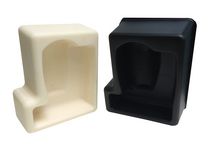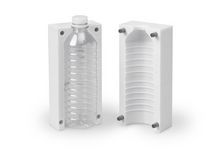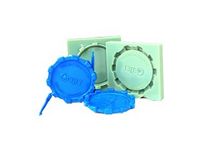- Commercial 3D printers & additive manufacturing solutions
- Order sample print
Thermoforming With PolyJet or FDM 3D Printer
Thermoforming is the collection of manufacturing methods that heat and form sheets of extruded plasticThe Thermoforming With PolyJet or FDM 3D Printer is great for:
- The packaging industry
- Large thermoformed parts such as hot tubs and refrigerator door panels
Thermoforming is the collection of manufacturing methods that heat and form sheets of extruded plastic. It is a relatively simple process that starts with heating a plastic sheet to a pliable state. Once softened, the sheet is forced against a mold with the desired shape using different methods: In vacuum forming, a vacuum is drawn through tiny holes in the mold. In pressure forming, air pressure is applied to the surface.
Thermoforming is mainly used in the packaging industry. However, it is not limited to small products; hot tubs and refrigerator door panels are two examples of relatively large thermoformed parts.
Virtually any thermoplastic available as extruded sheet stock may be used to thermoform prototypes or manufactured parts. Wall thicknesses can range from foils to thick-gauge stock — thicknesses ranging from 0.0005 to 0.5 in. (0.0127 to 12.7 mm) — with no molding stresses to combat. Vacuum forming part and tooling costs tend to remain reasonable for large parts.
Preparing tools for vacuum forming can be costly and time consuming. The tools are usually made of aluminum for large production operations. Wooden tools are sometimes used for small production series. Regardless of material, tooling requires the time and labor associated with setting up and operating a milling machine. If machining is unavailable onsite, tooling may be outsourced, slowing time to market and potentially increasing design expenses.
Because thermoforming doesn’t require extreme heat or pressure, 3D printing (also called additive manufacturing) is a viable alternative. Although tool life will not equal that of aluminum, the materials available with PolyJet or FDM Technology are ideal for prototyping and short-run manufacturing. Depending on the tool material and part material, tool life can range from 100 to 1,000 parts.
3D printing can eliminate much of the time and labor associated with machining vacuum-forming tools. Data preparation is completed in minutes, so tool construction can begin immediately after tool design. Automated, unattended operations eliminate the time needed for fixturing, setup and operation of CNC machines. FDM and PolyJet offer the option to design vent holes into the mold, eliminating the labor and potential unevenness of manual drilling. FDM further allows building the mold as a porous structure for finely distributed vacuum draw.
Application Checklist
PolyJet or FDM patterns are a best fit for thermoforming when:
- Smooth parts are required
- Challenging characteristics include deep draws or organic shapes
- Multiple designs are required
- Lead time is short
Benefits of PolyJet and FDM patterns for thermoforming include:
- Built–in vent holes to eliminate drilling
- Speed and reduced cost
- Smooth parts with little or no finishing
- Stability, eliminating heat distortion of the tool
Steps
- Prepare the 3D–printed tool: Print your thermoforming tool directly from the CAD file on an FDM or PolyJet system. Depending on technology & geometry, some finishing work may be necessary for the smoothest possible tool. This consideration is more important the thinner the thermoforming material.
- Place and heat the plastic sheet: Clamp the extruded plastic sheet stock in its frame above the tool. Apply heat until it is malleable.
- Prestretch: Introducing air between the tool and plastic sheet improves the consistency of wall thickness across the part.
- Raise the tool to meet the plastic sheet.
- Form the part: Pull a vacuum through the tool to draw the plastic sheet tightly to the tool’s surface.
Application Outline - PolyJet
Thermoforming molds built with PolyJet 3D printing are ready to use straight from the printer. The excellent surface quality eliminates the need for post processing, even when parts must have smooth surfaces. Accurate printing allows for vent holes to be designed nearly anywhere on the tool, promoting even draw.
Application Outline - FDM
The inherent porosity of tools 3D printed on an FDM system means drilling is unnecessary. Customizing the internal structure to reduce the amount of material used allows for additional time and cost savings. This custom interior can also be used to adjust the porosity around features such as deep draws.
Stratasys ABS–M30 material is suitable for most vacuum-forming applications. It offers mechanical properties that exceed the requirements of most thin-gauge sheets. The FDM process also offers materials that can withstand the high-temperature forming required for some thermoforming materials, such as polycarbonate, HDPE and Kydex. These FDM materials offer increased resistance to thermal degradation, often resulting in extended tool life. Their increased compression resistance makes them suitable for higher-pressure forming of thicker materials.
Stratasys Customer Story - FDM
Military aircraft are sophisticated tools for intelligence, surveillance, targeting and reconnaissance. A defense contractor uses FDM and vacuum forming to prototype and manufacture these complex systems. The company utilises a Fortus FDM system and Formech vacuum–forming system to reduce time, cost and labor demands for components including air ducts, engine cowlings and antennae covers. Vacuum forming replaces pre-impregnated carbon-fiber layup, which can be labor– and time–intensive.
Using FDM to construct a tool, vacuum forming begins in as little as one day after a design is complete, with minimal labor. Since vacuum forming parts takes only minutes, prototypes are done in less time than it would have taken to create a fiber layup tool.
When a functional prototype was needed for an antennae cover, FDM technology helped create a thermoforming mold. A Lexan cover was formed to replace the traditional composite cover. Lead time shrank by half, and cost went down 34 percent.
 Worcester (Head Office) 01905 458 000
Worcester (Head Office) 01905 458 000 3d@stanfordmarsh.co.uk
3d@stanfordmarsh.co.uk











